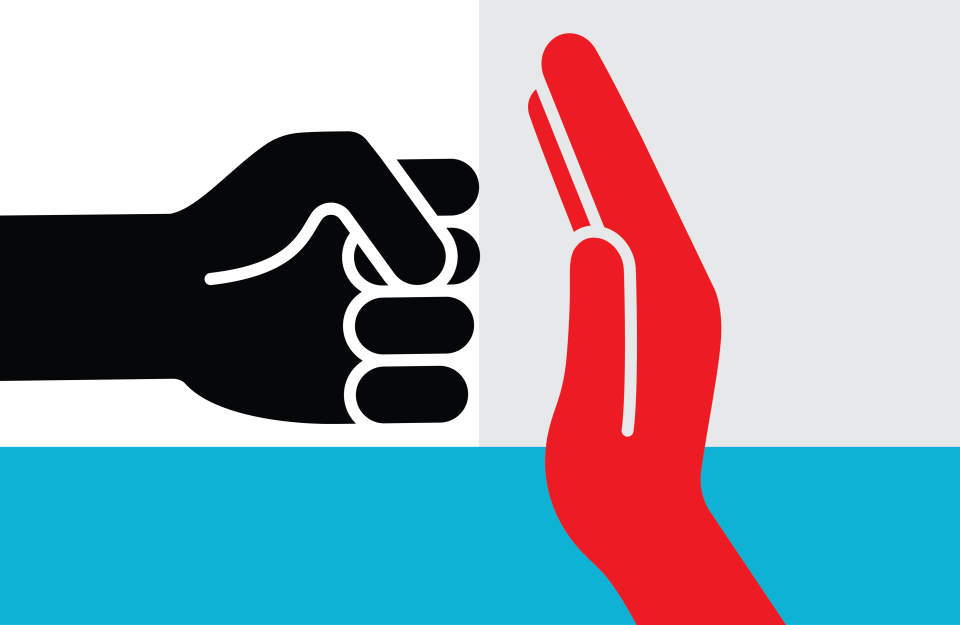What Can Be Done to Prevent and Resist Image-based Abuse?
A virtual symposium held by Annenberg’s Center for Media at Risk and the Cyber Civil Rights Initiative brought together experts from around the world to share findings, ideas, and solidarity.

Image-based abuse – commonly known as ‘revenge porn’ – is a pressing issue that has affected celebrities, athletes, politicians, and private citizens alike, and it has only become more pervasive during the COVID-19 pandemic. Broadly defined as the distribution of intimate images and videos of a person without their consent, this form of abuse has often been framed in popular media as the behavior of scorned ex-partners or individuals seeking revenge.
However, the problem is more nuanced and prevalent than public opinion may indicate: A 2020 study found that about one in twelve U.S. adults have experienced sexual image-based abuse.
Image-Based Abuse: Prevalence, Resistance, Prevention, a virtual symposium held by The Annenberg School for Communication’s’ Center for Media at Risk earlier this month, assembled an international group of researchers, policymakers, and activists to not only continue defining image-based abuse and raising awareness, but to share findings and resources, and strategize research agendas and policy recommendations.
Held in partnership with the Cyber Civil Rights Initiative (CCRI), a nonprofit that supports victims of cybercrimes, the event began with a keynote address by Mary Anne Franks, CCRI’s President and Professor of Law at the University of Miami.
What Is Image-Based Abuse and Why Does It Matter?
In her keynote, “What Is Image-Based Abuse and Why Does It Matter?”, Franks discussed her background as a legal scholar writing about the intersection of civil rights and technology, including the then-emerging phenomenon of revenge porn. Her involvement with the subject began when she was contacted by Holly Jacobs, a victim of nonconsensual pornography who launched a campaign called End Revenge Porn in 2012, and their work together led to founding the CCRI, which provides resources to online abuse victims through their Crisis Helpline and other services.
Franks and her colleagues have gravitated toward the term ‘image-based abuse’, coined by fellow symposium participant Claire McGlynn and Erica Rackley. As activists and scholars argue, ‘revenge porn’ is reductive, as offenders are motivated by a range of factors. It also implies a deserved retaliation rather than centering the abusive act itself, taking the focus away from victims and the harm they experience.
Image-based sexual abuse, Franks emphasized, is part of a constellation of behaviors that include not just nonconsensual pornography, but also sexual extortion and digital forgeries. Anyone can be a target, regardless of whether they’ve ever taken intimate photos or videos, as these can now be artificially created. Franks stressed the importance of understanding the history and dynamics of image-based abuse.
“As technology expands, everyone is going to become vulnerable to this type of attack,” she said. “Everyone will benefit from listening early on to the experiences of people who are being attacked and being exploited.”
Prevalence
The symposium’s first panel, Prevalence, assembled experts on identity-based harassment, privacy, and free speech to discuss digital abuse perpetration across demographics and the rise of image-based abuse amid the pandemic. The panel included Henry Ajder, an advisor and researcher on deepfakes and synthetic media; Amy A. Hasinoff, Associate Professor of Communication at the University of Colorado, Denver; Clare McGlynn, Professor of Law at Durham University, Mikiba W. Morehead, a cyber sexual abuse researcher and consultant, and moderator Julia Ticona, Assistant Professor of Communication at the Annenberg School.
Panelists discussed the rapidly growing use of deepfakes/synthetic media, with Aider sharing that such methods almost exclusively target women, though bisexual and gay men have been particularly targeted in regions where homosexuality is taboo or criminalized. As these technologies have become more accessible worldwide, there has been a shift from targeting well-known public figures to targeting private individuals, who often don’t have the means or resources to combat such abuse. Morehead noted that research data on the prevalence of nonconsensual pornography and sexual extortion during the pandemic shows increased rates of victimization for men, those in the LGBTQ+ community (particularly, bisexual men and women), and racial minorities including individuals of African-American or African descent and Indigenous Americans.
Resistance
The second panel, Resistance, featured Seyi Akiwowo, CEO and Founder, of Glitch; Jinsook Kim, a Postdoctoral Fellow at Annenberg’s Center for Advanced Research in Global Communication; Paz Peña, founder of Acoso.Online, a resource for online harassment victims in Latin America; survivor attorney Annie Schmutz Seifullah; and moderator Guobin Yang, Grace Lee Boggs Professor of Communication and Sociology at the Annenberg School. The conversation centered on victim-led movements that developed around the world to combat the rise of digital abuse, including lessons learned and ongoing challenges.
Kim shared that in South Korea, which has one of the world's highest rates of smartphone ownership, the government requires cellphone manufacturers to disable muting the camera shutter sound, making surreptitious photography more difficult. However, other measures have achieved limited success because of ever-evolving techniques such as harder to detect hidden cameras, and because many social networking and illegal porn sites keep their servers in places like the U.S., where they aren’t subject to South Korean laws.
Peña spoke of how many Latin American countries are discussing and enacting laws on digital gender-based violence, but progress is slow because tech platforms are less interested in countries outside the U.S., leaving them to their own devices on issues such as local content moderation.
“This neglect is a recipe for disaster and should be a call for solidarity networks in the U.S. to hold the platforms accountable to their users and victims of gender-based violence in different regions,” she said.
Prevention
The final panel, Prevention, featured Richard Aborisade, Associate Professor of Criminology and Victimology at Olabisi Onabanjo University; Nighat Dad, Executive Director of the Pakistan-based Digital Rights Foundation; Charley Johnson, Program Director of Data & Society’s Disinformation Action Lab; and moderator Sarah Banet-Weiser, Distinguished Professor of Communication at Penn’s Annenberg School for Communication, Professor at USC Annenberg School for Communication and Journalism, and Director of Annenberg’s Center for Collaborative Communication.
The discussion emphasized how cultural context and social norms are critical considerations in how online sexual abuse is understood and prosecuted. Policies and regulations can’t have a one-size-fits-all approach; what works in the Global North and Western democracies can have harmful consequences in the Global South, so more intersectional and global research is imperative.
Closing Conversation
The event concluded with a conversation between Asia Eaton, Research Director for the Cyber Civil Rights Initiative and Associate Professor of Psychology at Florida International University and Karuna Nain, Director of Global Safety Policy at Meta. In outlining possible next steps for tech companies seeking to challenge digital abuse, Nain underscored the need for platforms to get ahead of merely responding to harmful content by also giving users more control over their online privacy — for instance, a service that allows people to select concerning photos and videos directly from their devices, alerting participating companies to harmful content across platforms.
“There’s still a lot of burden on victims to go, one by one, onto each and every one of our platforms to get ahead of this harm,” Nain said. “I'm very optimistic that as we move from the defense to the offense, there's a lot more work that we have to do, but we're on the right track.”
The symposium also featured a digital self-care workshop, where image-based abuse activist Katelyn Bowden and Annenberg doctoral student and Center for Media at Risk Research Fellow Sophie Maddocks shared advice on safely researching digital abuse. The symposium was co-organized by Maddocks and Barbie Zelizer, Raymond Williams Professor of Communication, Associate Dean for Research, and Director of the Center for Media at Risk at the University of Pennsylvania’s Annenberg School for Communication.



